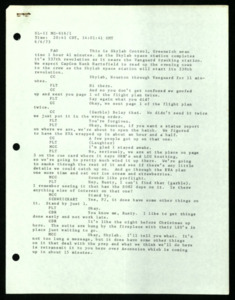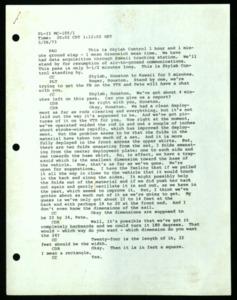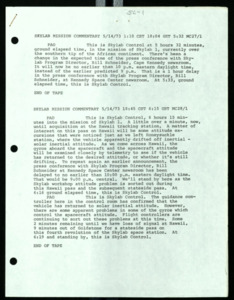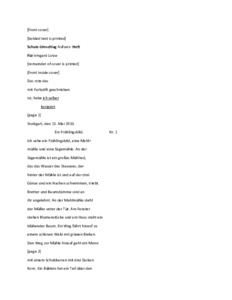
Browse Items (27 total)
Sort by:
-
Transcript of the World War I diary of Archie Duncan Shannon.
Archie Shannon was a farmer who served in Company G of the 1st Pioneer Infantry in World War I. Shannon was born in Limestone County, Alabama on November 19, 1891, and at the time of his draft registration on June 5, 1917, he lived in Ardmore, Tennessee. Shannon reported for military duty on September 18, 1917 and entered training at Camp Pike, Arkansas.
This diary covers Shannon's experiences in the U.S. Army from July 1, 1918 to July 7, 1919. He describes his journey to France and details everyday life as a soldier, especially the discomforts of life on the front in both the Marne and Verdun sectors. Shannon discusses bathing and sleeping arrangements, gas masks, air raids, and the terrible sights of war-torn France while repairing roads and burying dead soldiers. Shannon includes descriptions of his involvement in the Meuse-Argonne Offensive, noting the continuous shelling, gas attacks, and miserable weather conditions. He also describes his company's reaction to the Armistice, writing, "Many happy hearts in our company everyone seems to take life anew."
Shannon spent the rest of his World War I service in Belgium, Luxembourg, and Germany, and he returned to the United States on July 7, 1919. A list of soldier names and hometowns is recorded in the back of the diary. Shannon died on May 20, 1969 and is buried in Gatlin Cemetery in Ardmore, Alabama. -
Transcript of Irmgard Stuhlinger 1948 Journal
Irmgard Stuhlinger was the wife of Ernst Stuhlinger, a scientist acquired in Operation Paperclip. In this journal she details her daily life starting from January 1st, 1948 to December 31st, 1948. She touches on the topics of post-secondary education, family events, and holidays in the post-war period. At the end of the journal, she includes an entry about the year to come. -
"SL-III MC-1/1 Time: 05:01 CDT 09:10 GMT 7/28/73" - "SL-III MC-10/4 Time:06:08 CDT 09:11:08 GMT 7/8/73."
This mission commentary describes the Skylab 3 launch. -
"SL-II MC-616/1 Time: 20:41 CDT, 14:01:41 GMT 6/6/73" - "SL-II MC-630/1 Time: 07:57 CDT, 14:12:57 GMT 6/7/73."
This mission commentary primarily depicts the Skylab 2 crew working on, and maintaining the Apollo Telescope Mount systems. -
"SL-II MC-114/4 Time: 21:36 CDT 01:13:36 GET 5/26/73" - "SL-II MC-117/4 Time: 23:47 CDT, 1:15:47 GET 5/27/73."
This mission commentary primarily depicts the Skylab 2 crew transitioning to permanent habitation in the Skylab 1 Orbital Workshop from the Skylab 2 Command module. -
"SL-II MC-109/1 Time: 20:02 CDT 1:12:02 GET 5/26/73"-"SL-II MC-114/3 Time: 21:36 CDT 01:13:36 GET 5/26/73."
This mission commentary primarily depicts the Skylab 2 crew finishing their work on the solar parasol. This mission commentary also depicts the discussion between the Skylab 2 crew and ground control about the permanent move to habitation in the Orbital Workshop. -
"Time: 17:15 p.m. CDT, 1:09:15 GET SL-II MC102/1 5/26/73" - "SL-II MC-108/1 Time: 19:53 p.m. CDT 1:11:53 GET 5/26/73."
This mission commentary primarily depicts the Skylab 2 crew unpacking and assembling the solar parasol. The Skylab 2 crew is also depicted deploying the solar parasol. -
"SL-II MC-97/1 Time: 3:23 p.m. CDT, 1:07:23 GET 5/26/73" - "SL-II MC-101/2 Time: 4:56 p.m. CDT 1:08:56 GET 5/26/73."
This mission commentary primarily depicts the Skylab 2 crew discussing the deployment of the parasol for the alleviation of temperature pressures. The Skylab 2 crew is also depicted making the preparations for the deployment of the solar parasol. -
"SL-II MC-88/2 Time: 1:34 p.m. CDT, 1:05:34 GET 5/26/73" - "SL-II MC-96/1 Time: 15:13 p.m. CDT 1:07:13 GET 5/26/73."
This mission commentary primarily depicts the Skylab 2 crew carrying out maintenance on the life support systems. This mission commentary also depicts the Skylab 2 crew operating the Apollo Telescope Mount. -
"SL-II MC-81/1 Time: 11:44 a.m. CDT, 1:03:44 GET 5/26/73" - "SL-II MC-88/1 Time: 1:34 p.m. CDT 1:05:34 GET 5/26/73."
This mission commentary depicts the Skylab 2 crew trying to resolve a low temperature problem in the scientific airlock. The commentary also depicts the Astronaut assessment of the Orbital Workshop high temperature problems. -
"SL-II MC75/3 Time: 10:17 a.m. CDT, 1:02:17 GET 5/26/73" - "SL-II MC-79/3 Time: 11:24 a.m. CDT 1:03:24 GET 5/26/73."
This mission commentary depicts the Skylab 2 crew working to secure the fastening between the Skylab 2 command module and the Skylab 1 habitat. This mission commentary also depicts the Skylab II crew working on the life support systems. -
"SL-II MC-64/2 Time: 01:25 CDT 17:25 GET 5/25/73" - "SL-II MC 75/2 Time: 10:17 a.m. CDT 1:02:17 GET 5/26/73."
This mission commentary depicts the improving temperature conditions on Skylab 1 following the Skylab 2 crew's efforts to resolve the temperature problems. -
"SL-II MC-60/1 Time: 22:50 CDT 14:50 GET 5/25/73" - "SL-II MC 64/1 Time: 01:25 CDT 17:25 GET 5/25/73."
This mission commentary depicts Skylab 2 docking with Skylab 1. This mission commentary also depicts the Skylab 2 crew beginning work on resolving the solar panel and micrometeoroid shield problems. -
"SL II MC 1/1 Time: 6:32 a.m. CDT, T-01:25:00 GET 5/25/73" - "SL-II MC-11/3 Time: 08:01 A.M. CDT, T-1 minute Get 5/25/73."
This mission commentary depicts the Skylab 1 launch. -
"Skylab Mission Commentary 5/14/73 1:10 CST 18:04 GET 5:32 MC27/1" - "Skylab Mission Commentary 5/15/73 1:20 CST MC38/1."
This mission commentary depicts NASA's attempts to alleviate some of the temperature issues caused by the broken micrometeoroid shield on Skylab 1. -
"Skylab Mission Commentary 5/14/73 1:10 CST 18:04 GET 5:32 MC27/1" - "Skylab Mission Commentary 5/15/73 1:20 CST MC38/1."
This mission commentary depicts the initial discovery of Skylab 1's Orbital Workshop Solar arrays not deploying as intended. -
Transcript of Irmgard Stuhlinger 1944-1945 Journal
Irmgard Stuhlinger was the wife of Ernst Stuhlinger, a scientist acquired in Operation Paperclip. In this journal she details her daily life starting from her 19th birthday under the rule of the Third Reich, toward the end of the second World War. She touches on topics such as war, post-secondary education, death of family members, the acquisition of housing, and holidays in the latter part of the war. -
Transcript of Irmgard Stuhlinger School Essays, 1934-1935
Irmgard Stuhlinger was the wife of Ernst Stuhlinger, a scientist acquired in Operation Paperclip. In these school essays, she discusses her daily life in Stuttgart, Germany, as a child. When writing these essays she was 9-10 years old. Topics of the essays include family life, a fictional moral story, descriptions of the weather, as well as significant historic events such as the Saarabstimmung (1935 Saar status referendum). Furthermore, she mentions Adolf Hitler (German chancellor) and the Sturmabteilung (Paramilitary organization run by Nazi Germany) in these essays. The transcript includes a description of each illustration. -
Transcript of Irmgard Stuhlinger School Essays, from No. 15
Irmgard Stuhlinger was the wife of Ernst Stuhlinger, a scientist acquired in Operation Paperclip. In these school essays, she discusses her daily life in Stuttgart, Germany, as a child. When writing these essays she was 8-9 years old. Some of the topics include letters to family members, a fictional story, Christmas, descriptions of the weather, and talking about field trips. -
Transcript of Irmgard Stuhlinger School Essays, No. 1 to No. 13
Irmgard Stuhlinger was the wife of Ernst Stuhlinger, a scientist acquired in Operation Paperclip. In these school essays, she discusses her daily life in Stuttgart, Germany, as a child. When writing these essays she was 8 years old. Some of the topics include a letter to family members, Christmas, descriptions of the weather, and talking about field trips. -
Transcript of 1945-1946 Journal of Gerhard Reisig Dipl.-Ing.
Gerhard Reisig Dipl.-Ing., later Dr. Gerhard Reisig, was a German-American rocket scientist that worked on the team of von Braun at Fort Bliss. This journal covers his journey to the United States under Operation Paperclip, and includes descriptions of his experience to and through his arrival on December 6th, 1946. In this journal, he discusses numerous parts of his travel and experience in the United States including the rail route taken by the group he was in, reviews of two films of the time, comments on fashion and American society, as well as periodic mentions of food culture especially early in the journal. The transcript includes links to copies of the articles he transcribed by hand if they could be found. -
"Apollo 7 Mission Commentary."
This document contains the transcript from the Apollo 7 mission. This transcript contains the communication from the first seven days of the ten day mission. -
"Chemistry in Space Boosters" presentation given at Huntsville High School.
The document is a draft of the presentation "Chemistry in Space" by Harold Perkins, who explains the role of chemists in developing space launch vehicles. The document Includes references to charts and other presentation supports. The document is marked in the upper left hand corner "Huntsville High School Science Organization (the JETS), October 1962." -
Transcript of "Trial by Fire and Water: Birmingham, 1963" (Part I).
Rev. Fred Shuttlesworth is the speaker in this lecture given at Alabama A&M. -
Transcript of the Civil War diary of George Washington Harris.
Harris served as a private in Company F of the 149th Indiana Infantry Regiment, which occupied Decatur, Alabama in 1865. He enrolled at Terre Haute, Indiana, on February 15, 1865 at the age of twenty. Harris records his experiences as a soldier and traces his journey south to Decatur. Harris was discharged on September 27, 1865. The transcription includes a key to the cipher that Harris sometimes used, as well as notes and clarifications in brackets and parentheses. Also included are the complete lyrics to the Union song "Reply to the Bonnie Blue Flag," part of which Harris records in an entry here. -
Transcript of a speech given by Wernher von Braun to the Alabama Legislature.
Von Braun, then the director of Marshall Space Flight Center in Huntsville, Alabama, delivered this speech to the legislature in 1961. In the speech, he emphasizes that Alabama must take advantage of its position in the aerospace industry and create a robust "academic and research environment" in Huntsville to attract businesses that "will give birth to major new industries throughout the state." He exhorts the legislature to fund the newly established University of Alabama Research Institute (now part of the University of Alabama in Huntsville), arguing that "the Institute will not only be self-sustaining, but will enrich the State both financially and culturally." The legislature later approved von Braun's request of $3 million for the Research Institute, enabling the purchase of 200 acres of land for the campus and the construction of the Institute in 1964. The speech includes copies of slides von Braun used during his presentation, including diagrams of Saturn and Nova rockets as well as a mockup of a Saturn rocket on the lawn of the state capitol in Montgomery.


























